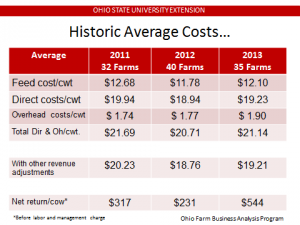By Dianne Shoemaker
We are starting 2016 with Class III milk prices dipping into the $13 per cwt range for multiple months in the futures market. (Compare to the annual averages of $15.80 for 2015 and $22.34 for 2014). We last saw $13 for several months in 2010 and January of 2011. This sure means something for Ohio dairy farms, but what?
Thirty-eight Ohio dairy farms completed whole farm and enterprise analysis for 2014. This investment pays them back with tools to identify strengths and areas for improvement across their farm. We remember 2014 as the brief time when milk prices were at an all-time high…rapidly followed by 2015 with milk prices falling to 5-year lows.
2014’s returns were phenomenal. Looking at Table 1, the average net return per cow for all herds was $1,266 per cow. This was higher than the average per-cow returns for the previous 3 years added together! These returns are not just cash heading to the bank or the dealership for a new truck; they have work to do. With the net returns, the farms have to pay themselves. Hired labor is already deducted from these net returns, but the owner’s labor and management is not. They are also used to make principal payments, pay income taxes, save for retirement, and reinvest in the farm businesses.
Table 1: Comparison of total cost of production per cwt. and net return per cow, 2011 – 2014 Ohio Dairy Farm Business Analysis. Raised feed valued at cost of production.
The most pressing challenge we see in Table 1 comes when we look at the total cost of producing a hundred pounds (cwt.) of milk. For the past 4 years, it averaged $19.66 for these Ohio farms. This cost is already reduced by the income received for the sale of bull calves, cull cows, etc. The only non-cash cost is a depreciation charge for the use of the farm’s machinery and equipment (7% of the inventory value used for the dairy enterprise), titled vehicles (15%), and buildings and improvements (5%).
On the farm, we have received an average of about 85 cents per cwt above the Class III price for our milk in Federal Order 33. The analysis farms have also received an average of $2.20 more per cwt between 2011 and 2014. These additional dollars came from combinations of higher components, quality and quantity premiums, and over-order premiums. Add all that up, and many farms are going to come up anywhere from $1 to $3 per cwt short of the cash cost of producing milk, say nothing of the unpaid labor, principal payments, etc.
How to target cost savings will be the subject of my next column. To learn more, download the complete 2014 Dairy and Crop Enterprise Analysis Summaries from farmprofitability.osu.edu.















